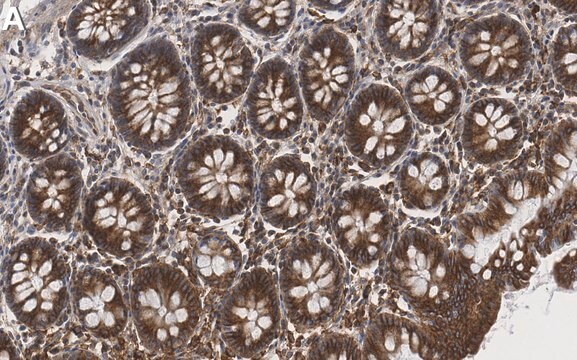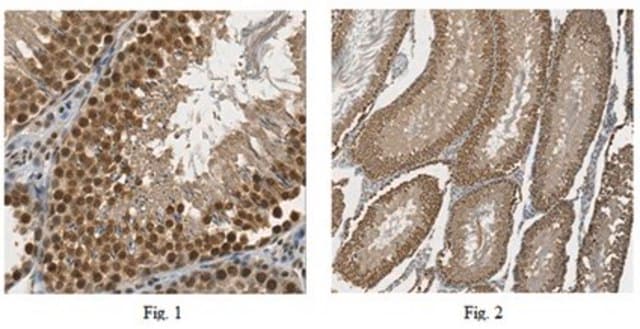General description
We are committed to bringing you greener alternative products, which adhere to one or more of The 12 Principles of Green Chemistry.This antibody is Preservative-free, produced without the harm or sacrifice of animals and exceptionally stable to allow for ambient shipping and storage if needed and thus aligns with "Waste Prevention", "Designing Safer Chemicals" and "Design for Energy Efficiency".
Click here for more information.
ZooMAb® antibodies represent an entirely new generation of recombinant monoclonal antibodies.Each ZooMAb® antibody is manufactured using our proprietary recombinant expression system, purified to homogeneity, and precisely dispensed to produce robust and highly reproducible lot-to-lot consistency. Only top-performing clones are released for use by researchers. Each antibody is validated for high specificity and affinity across multiple applications, including its most commonly used application. ZooMAb® antibodies are reliably available and ready to ship when you need them.
Specificity
Clone 1G4 is a ZooMAb® Rabbit recombinant monoclonal antibody that specifically detects GLI-2. It targets an epitope within 23 amino acids from the N-terminal half of human GLI-2. Predicted to react with all isoforms.
Immunogen
KLH-conjugated linear peptide corresponding to 23 amino acids from the N-terminal half of human GLI-2.
Application
Quality Control Testing
Evaluated by Western Blotting in Jurkat cell lysate.
Western Blotting Analysis: A 1:1,000 dilution of this antibody detected GLI-2 in Jurkat cell lysate.
Tested Applications
Western Blotting Analysis: A 1:1,000 dilution from a representative lot detected GLI-2 in K562 and U2OS cell lysates.
Affinity Binding Assay: A representative lot of this antibody bound GLI-2 peptide with a KD of 7.0 x 10-6 in an affinity binding assay.
Immunocytochemistry Analysis: A 1:1,000 dilution from a representative lot detected GLI-2 in U2OS cells.
Note: Actual optimal working dilutions must be determined by end user as specimens, and experimental conditions may vary with the end user.
Target description
Zinc finger protein GLI2 (UniProt: P10070; also known as GLI family zinc finger protein 2, Tax helper protein) is encoded by the Gli2 (also known as THP) gene (Gene ID: 2736) in human. In vertebrates three Gli proteins (Gli-1, Gli-2, and Gli-3) have been described that despite the presence of several homologous regions, including a DNA-binding domain with five C2-H2 zinc fingers and a C-terminal transcription activation domain, have distinct activities and are not considered to be functionally equivalent. Gli-1 and Gli-2 function primarily as activators whereas Gli-3 has a repressor role. Gli-2 contains five C3H2-type zinc fingers. Its N-terminal domain confers transcriptional repressor activity, while the C-terminal domain mediates transcriptional activation. Transcriptional activity of Gli proteins is also regulated through its binding to Suppressor of Fu (Sufu), which is a negative regulator of Hedgehog signaling in Drosophila as well as in vertebrates. Sufu binds to all three Gli proteins with different affinities. Phosphorylation of Gli-2 by DYRK2 is shown to block its transcriptional activity and promotes its proteasomal degradation. Gli-2 is reported to be essential for normal embryonic development. Gli-2 affects ventroposterior mesodermal development through its regulation of Wnt, Brachyury and Xhox3 gene families. Knockout studies have shown that Gli-1 can compensate for Gli-2, but replacement is not perfect and is context dependent. Gli-2 null mice embryos develop neural tube defects and double knockout Gli1 and Gli-2 mice display serious central nervous system and lung defects. Overexpression of Gli-2 has been linked to tumorigenesis and can lead to basal cell carcinomas. Mutations in Gli-2 gene have been linked to holoprosencephaly 9 that is characterized by failure of forebrain to correctly separate into right and left hemispheres. Gli-2 gene mutations are also known to cause Culler-Jones syndrome that features pituitary dysfunction, syndactyly, hypothalamic hamartoma, and visceral malformations. Five isoforms of Gli-2 have been described that are produced by alternative splicing. This ZooMAb® recombinant monoclonal antibody, generated by our propriety technology, offers significantly enhanced specificity, affinity, reproducibility, and stability over conventional monoclonals. (Ref.: Tolosa, EJ., et al. (2020). Biochem. J. 477(17); 3131-3145; Roessler, E., et al. (2003). Proc. Natl. Acad. Sci. USA. 100(23); 13424-13429).
Physical form
Purified recombinant rabbit monoclonal antibody IgG, lyophilized in PBS with 5% Trehalose, normal appearance a coarse or translucent resin. The PBS/trehalose components in the ZooMAb formulation can have the appearance of a semi-solid (bead like gel) after lyophilization. This is a normal phenomenon. Please follow the recommended reconstitution procedure in the data sheet to dissolve the semi-solid, bead-like, gel-appearing material. The resulting antibody solution is completely stable and functional as proven by full functional testing. Contains no biocide or preservatives, such as azide, or any animal by-products. Larger pack sizes provided as multiples of 25 μL.
Reconstitution
300 μg/mL after reconstitution at 25 μL per vial. Please refer to guidance on suggested starting dilutions and/or titers per application and sample type.
Storage and Stability
Recommend storage of lyophilized product at 2-8°C; Before reconstitution, micro-centrifuge vials briefly to spin down material to bottom of the vial; Reconstitute each vial by adding 25 μL of filtered lab grade water or PBS; Reconstituted antibodies can be stored at 2-8°C, or -20°C for long term storage. Avoid repeated freeze-thaws.
Legal Information
ZooMAb is a registered trademark of Merck KGaA, Darmstadt, Germany
Disclaimer
Unless otherwise stated in our catalog or other company documentation accompanying the product(s), our products are intended for research use only and are not to be used for any other purpose, which includes but is not limited to, unauthorized commercial uses, in vitro diagnostic uses, ex vivo or in vivo therapeutic uses or any type of consumption or application to humans or animals.










